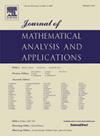Lattice Lipschitz superposition operators on Banach function spaces
IF 1.2
3区 数学
Q1 MATHEMATICS
Journal of Mathematical Analysis and Applications
Pub Date : 2025-01-10
DOI:10.1016/j.jmaa.2025.129233
引用次数: 0
Abstract
We analyze and characterize the notion of lattice Lipschitz operator when defined between Banach function spaces. After showing some general results, we restrict our attention to the case of those Lipschitz operators which are representable by pointwise composition with a strongly measurable function. Mimicking the classical definition and characterizations of (linear) multiplication operators between Banach function spaces, we show that under certain conditions the requirement for a diagonal Lipschitz operator to be well-defined between two such spaces and is that it can be represented by a strongly measurable function which belongs to the Bochner space . Here, is the space of multiplication operators between and , and is the space of real-valued Lipschitz maps with real variable that are equal to 0 in 0. This opens the door to a better understanding of these maps, as well as finding the relation of these operators to some normed tensor products and other classes of maps.
求助全文
约1分钟内获得全文
求助全文
来源期刊
CiteScore
2.50
自引率
7.70%
发文量
790
审稿时长
6 months
期刊介绍:
The Journal of Mathematical Analysis and Applications presents papers that treat mathematical analysis and its numerous applications. The journal emphasizes articles devoted to the mathematical treatment of questions arising in physics, chemistry, biology, and engineering, particularly those that stress analytical aspects and novel problems and their solutions.
Papers are sought which employ one or more of the following areas of classical analysis:
• Analytic number theory
• Functional analysis and operator theory
• Real and harmonic analysis
• Complex analysis
• Numerical analysis
• Applied mathematics
• Partial differential equations
• Dynamical systems
• Control and Optimization
• Probability
• Mathematical biology
• Combinatorics
• Mathematical physics.

 求助内容:
求助内容: 应助结果提醒方式:
应助结果提醒方式:


